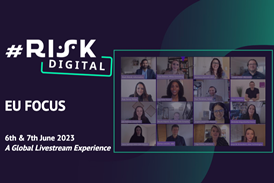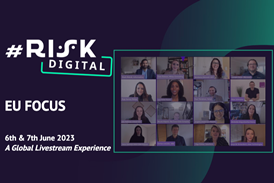Andrew Perry is Director at Faculty AI, where he leads the Energy Transition and Environment business unit.

Andrew was a guest speaker at #RISK A.I. Digital this month, where he looked at how organisations can become AI-enabled, and the challenges they must navigate for this to happen.
Below, Andrew goes over his professional journey to date and talks about the key issues of his #RISK A.I. session, “Creating an AI enabled Organisation.”
Could you outline your career pathway so far?
My career journey began in management consulting before I moved into the energy sector in 2009 to join what was then the UK government’s Department of Energy and Climate Change to lead on Smart Grids. That role then evolved into heading up policy on Electricity Systems Strategy during an interesting stage in the energy transition where we were discovering many of the implications of transition for the first time.
This period was marked by the rapid growth of renewables such as wind and solar power. However, there was little understanding of their impact on the energy system. My focus was on understanding and defining the concept of flexibility in the energy transition, which was still a relatively nascent idea at the time. This focused on the challenge of integrating intermittent renewable generation at scale into a system with fixed demand both from an energy markets and networks perspective.
After my period in government, I returned to consulting in energy at DNV GL where I led a team advising businesses on navigating the evolving market and regulatory landscape. Subsequently, I was a founder member of a start-up called Tempus Energy. Our business model centred upon creating more flexibility through development of a demand-side response platform that would optimise energy usage depending on changing energy prices, shift customer demand, and bring down customers’ costs.
Despite regulatory hurdles, Tempus Energy grew quickly and we got a lot of press attention, especially when we took the government to the European Court (and eventually won)! It was an amazing experience, but we were ultimately a few years early with our model in the market and it didn’t work out. I then joined Oliver Wyman to strategically advise energy and utility companies both in the UK and globally.
After nearly five years at Oliver Wyman, I had an exciting opportunity to join Faculty, an applied AI company. They were looking to establish a new business unit focused on the energy sector and approached me to lead the initiative. This role sat well with my interests in both the energy transition and the application of new technologies.
Starting from scratch and with no clients, I built a team and developed tailored AI solutions for businesses in the energy sector. Over the past two years, our team has grown substantially – we are now up to 25 people – and we have established a strong client base, particularly within network companies. We collaborate with entities such as National Grid, NPG and SGN, with our now expanding our reach into other sectors like water and renewable generation.
What does it mean to create an AI-enabled organisation?
Creating an AI-enabled organisation involves leveraging the capabilities of artificial intelligence to transform various aspects of business operations.
While AI is not a new concept and has been evolving for decades, recent advancements, particularly in generative AI, have sparked a surge of interest and excitement. AI is now doing for language what it only previously did for numbers, and it’s unlocking images and video too.
The ability of AI to handle unstructured data opens up new opportunities for organisations to extract valuable insights and optimise processes. This shift signifies a transformation similar to the digital revolution of the past few decades, where businesses transitioned from being technology-adjacent to being technology-driven. AI isn’t going to be a vertical that sits separately and does other things. In the coming years, AI will become a horizontal layer that runs over everything organisations do.
An AI-enabled organisation will instinctively seek AI-driven solutions to enhance efficiency, decision-making, and overall performance. This requires a shift in mindset, where AI is not seen as a standalone analytics tool but as operational tooling that streamlines processes and augments human capabilities. In future, the best businesses will be the ones that think how they can improve through using AI to enhance their processes and decision-making capabilities.
To realize the full potential of AI, organisations need to cultivate a diverse set of capabilities. This includes relying on data scientists who can develop algorithms and models tailored to specific business needs, engineers who can build robust systems to integrate AI solutions seamlessly, and business users who can provide insights and feedback to drive innovation.
Bridging the gap between technical and business functions is essential to ensure that AI initiatives align with goals and priorities. By nurturing these capabilities and building collaboration, organisations can effectively harness AI to optimise processes and drive innovation.
An AI-enabled business understands its transformation needs without becoming overwhelmed by building everything from scratch. Instead, it focuses on quick wins with minimal overhead. Most importantly it recognises that the greatest value does not come from static analysis but from enhanced operational tooling that is robust, consistent and repeatable.
By automating tasks like data collection and synthesis, summarisation and authoring, organisations can streamline workflows previously reliant on extensive manual effort. This approach saves time and resources while empowering employees to focus on quality assurance and further enhancements.
What are the primary challenges that organisations face as they bid to innovate with AI responsibly and ethically
One of the biggest challenges concerns getting around the widespread belief that you need to have a perfect, integrated database for AI implementation. No organisation in history has ever had this and no one ever will because the world is far too fluid.
We see a lot of people wrapped up in this desire for fully comprehensive structured data and they forget the overall purpose. You can spend years trying to create the perfect digital edifice without getting any value from it.
Instead, organisations should focus on the targeted structuring of data, aligning with specific use cases and business objectives.
Another challenge lies in shifting from static analytics to operational tooling. Traditionally, businesses procure technology solutions rather than developing their own. However, to fully leverage AI’s potential, organisations must become empowered creators of tailor-made solutions aligned with their unique operations and data. It’s about making a significant cultural shift towards ownership and innovation, where businesses actively develop solutions rather than passively consume them.
To lead on this, you’re going to have to do a lot of stuff yourself, rather than waiting. If you wait a couple of years, a generic product may eventually come out, but you will already have fallen behind your competitors. So, there’s a strategic imperative to be proactive in AI adoption.
For instance, a legal recruitment firm used a product that we brought to them – a bespoke AI tool that streamlined job description creation, reducing their production lead time from days to minutes.
This significantly reduces their costs and improves the quality and consistency of their outputs, but most importantly it means they can turn around job ads much more quickly than their competitors. Organisations that delay AI adoption risk missing out on such transformative opportunities.
On top of this is the challenge of building the necessary capabilities for AI implementation. You need data scientists and AI engineers, and you need to link them together in a way that’s productive.
CDO/CTO/CIOs will play pivotal roles in spearheading this transformation, ensuring that AI initiatives align with business objectives and drive tangible impacts on both top-line and bottom-line performance.
Finally, there’ll be natural hesitancy and pushback to all of this. Employees may have concerns about their roles or they may lack the skills required to adapt to AI-driven workflows. Indeed, some roles won’t be needed anymore, but other new positions will be created over time.
Smoothing this transition requires proactive efforts to retrain and reskill the workforce, ensuring that employees are equipped to thrive in an AI-enabled environment. For some businesses, this change will be tough, but they’ll have to adapt if they are to survive.
Stay on top of the global AI debate
GRC, Data Protection, Security and Privacy professionals face ongoing challenges to help mitigate risk, comply with regulations, and help achieve their business objectives - they must…
- Continually adopt new technologies to improve efficiency and effectiveness.
- Build a culture of compliance and risk awareness throughout the organisation.
- Communicate effectively with stakeholders and keep them informed of GRC activities.
PrivSec & GRC Connect Chicago takes you to the heart of the conversation, uniting the most influential GRC, Data Protection, Privacy and Security professionals, to present, debate, learn and exchange ideas.
This dynamic and content-rich experience takes place over April 16-17 at the Crowne Plaza Chicago West Loop.
Click here to register for free to PrivSec & GRC Connect Chicago















No comments yet